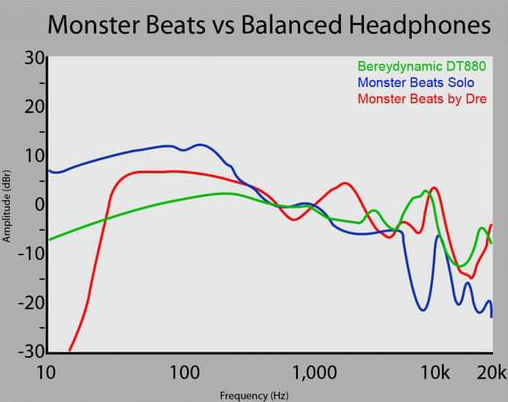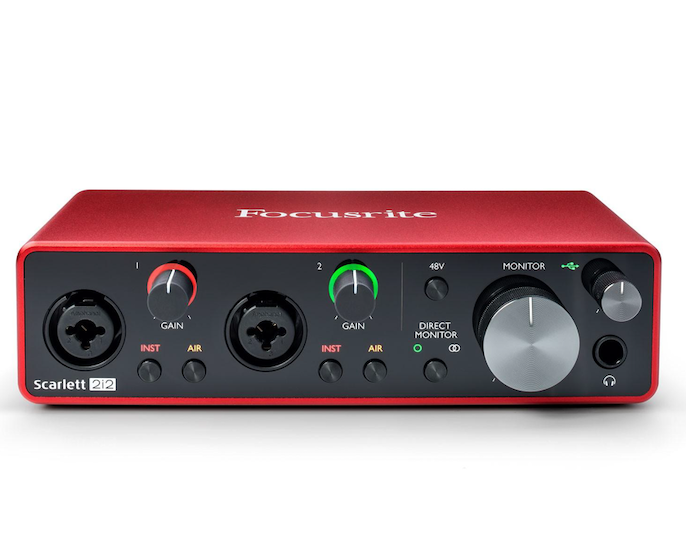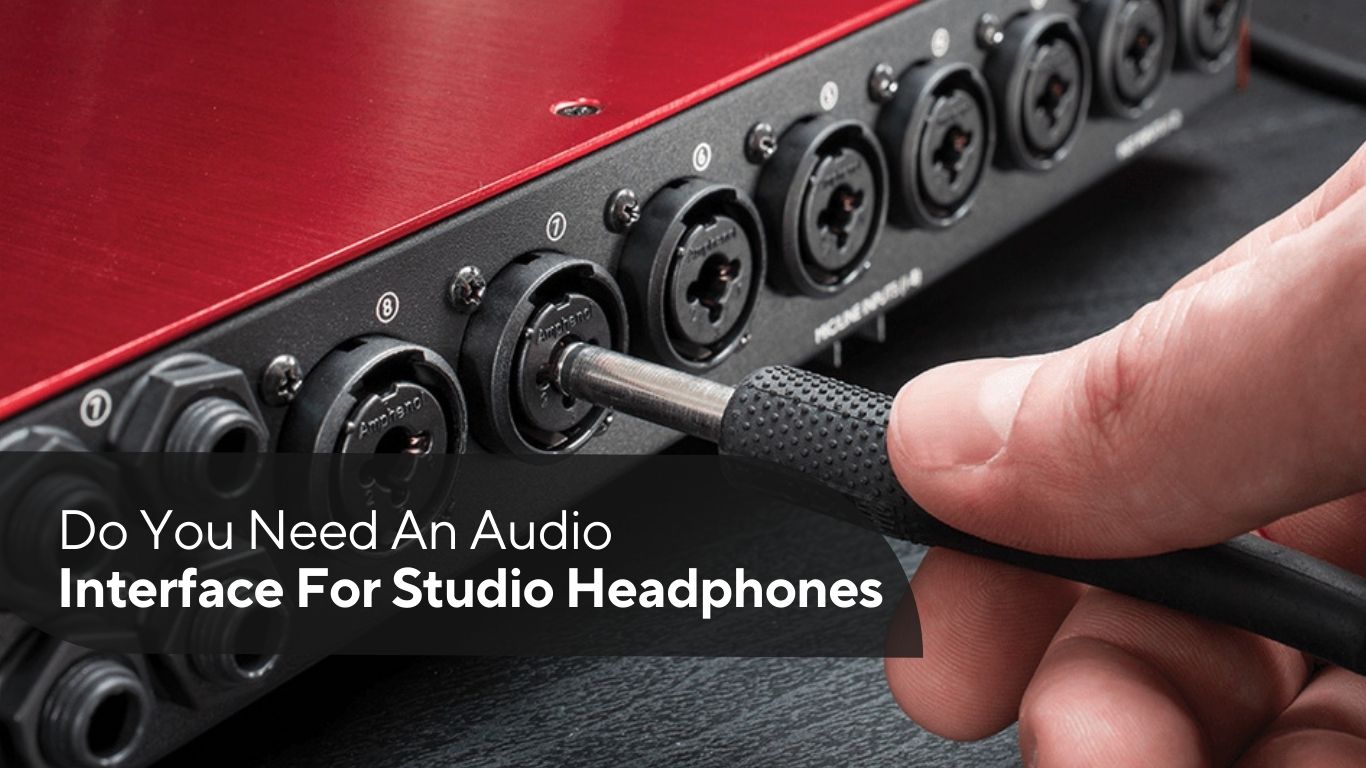Wondering what the hype is all about, and why “industry professionals” keep telling you that you need an audio interface when your brand new pair of Sennheiser studio headphones work just fine with the headphone output of your laptop? In this article I go in depth on studio headphones, audio interfaces and the various reasons why the two of these items make such a good pair, so if that sounds interesting to you then keep reading!
What Are Studio Headphones?
Studio headphones are just that, headphones created by companies such as Sennheiser and AKG for use specifically within the studio. Unlike generic or gaming headphones, studio headphones are built with the engineer who needs to make precise adjustments to audio clips in mind. While generic and gaming headphones generally have boosted bass and treble, studio headphones try to represent a flat frequency response, and their ability to recreate audible frequencies are generally also much better (usually ranging from 20Hz to 20kHz, while more high end studio headphones tend to extend this range from 15Hz to 40kHz). If you want to learn more about studio headphones and whether their superior sound quality translates into a better experience when listening to music, checkout this article: Are Monitor or Studio Headphones Good for Listening to Music?

Different Types Of Studio Headphones
There are different types of studio headphones for different scenarios within the studio. The 2 main types are closed back and open back headphones, while the rest include semi-open back headphones, wireless studio headphones and extremely light headphones.
Closed back headphones tend to have superior sound quality over open back headphones, while open back headphones avoid pressure build-up within the ears (which could cause long term damage). Open back headphones also tend to be lighter and generally more comfortable, meaning that they are the perfect choice for longer mixing sessions. If you are on a budget and looking for a new pair of closed back studio headphones, checkout our list on the Top 10 Best Closed-Back Headphones Under $100.
What Is An Audio Interface
An audio interface is a device that acts as sort-of the middleman between you and your computer. It allows you to record analogue sounds into your DAW by converting these sounds into a digital format that your computer can understand, while also allowing you to hear these sounds back in an analogue format once your computer has processed it. The basic audio interfaces normally have an XLR input for microphones, a quarter inch jack input for instruments and line level signals, separate gain controls for each of these inputs, a 48v switch to provide phantom power to condenser microphones, a big volume knob to control the overall mix of your audio, a Direct Monitoring switch, RCA connectors for studio monitors and a headphone output jack for studio headphones with its own separate volume control. They normally connect to your computer via USB, although some models use different methods. Audio interfaces usually have decent preamps and ADCs (Analogue to Digital Converters) to improve the quality of your recordings, while also boasting superior output quality for audio referencing.

Different Use Cases
So now that you know a bit more about studio headphones and audio interfaces, let’s explore the different scenarios where you might want to pair the two.
Bedroom Studios
Audio interfaces are a great choice for most recording scenarios. I’ve already discussed the inputs and outputs of the basic audio interface, but there are other more serious options too. Some of these interfaces have two headphone outputs, each with their own separate volume controls which means that you can record someone’s vocals while giving them the ability to be in charge of their own mix. This also works well for cases where you mix a song with someone else and speakers aren’t an option. If your interface only has one headphone output like mine, don’t be worried as there is a workaround! All you have to do is get an RCA to female aux cable and connect this to the back of your interface. You won’t be able to control the volume separately, but at least this way you can still use two headphones simultaneously.
If you have two or more headphones in your drawer like I do and their cables keep getting tangled together, checkout this article on How To Stop Headphone Cables From Curling [11 Tips]
Matching Impedance (Resistance)
Generic headphone ports in computers and smartphones(DACs) usually have pretty low output impedance while studio headphones tend to have high load impedance (over 100 ohms), so getting an audio interface with matching output (or source) impedance will ensure better audio sensitivity and efficiency, resulting in better sound quality.

Monitoring Latency & Direct Monitoring
We’ve all experienced audio latency when working in DAWs, you hit a button on your keyboard but it feels like it takes forever for the sound to come through your headphones, making recording a nightmare… This is because the devices and drivers that convert digital signals into analogue sound in computers and generic sound cards are mass produced meaning that they are made from cheap materials with drivers created to work on just about any computer, regardless of its hardware. Audio interfaces on the other hand are expensive for a reason, they are made from good materials. They also have dedicated drivers, created for specific units which results in much quicker signal conversion.
Additionally, most audio interfaces have a “direct monitor” switch. This sends the incoming signal directly to the outputs so that you can immediately hear the sound before it even reaches the computer. This is great because it means you can hear and tweak your sounds before you even start recording, eliminating the need to record over and over to find the perfect tone. However, it should be noted that as the signal bypasses the computer entirely, you can’t process it before you hear it. Personally, I use this function to play guitar through my headphones at night so I don’t disturb my housemates and neighbours.
Going back to the bedroom studio, the Direct Monitoring function can also be used to send someone’s vocals directly to their headphones so that they can hear themselves. In cases where you have a control and live room, this function can also be used for talkback.
Reamping & Re-recording Sounds
If you have a clean or raw sound that you want to process with an external unit, such as a recording of an electric guitar that you want to send through one of your amps, you can use the headphone output of your audio interface as an input into the amp. You can then re-record that sound using a mic, or if you are processing your sound with an external effects unit you can use the line input. I use this trick often for changing my clients guitar tones, but you have to be careful as it can create a feedback loop. The most important thing to remember here is to turn off the direct monitoring function, both on your interface and in your DAW.
Conclusion
The short answer is no, you don’t need an audio interface for studio headphones… They cost a lot and can sometimes be tricky to set up and connect. If you are just someone who creates music digitally or who works with audio using headphones then perhaps getting a high quality sound card or finding headphones with complementary impedance to the DAC you use now is a better option. However, the cheaper audio interfaces still offer better audio quality than most of the higher end sound cards, so if clarity and quality is important to you, or if you are a recording engineer who needs something for one of the use cases above then the choice is obvious.
Thinking of replacing an old pair of studio headphones due to a loose or worn out headphone jack? Checkout this article on how to fix the problem yourself: [Quick Guide] How to Fix A Loose & Worn Out Headphone Jack
Do you go through multiple pairs of headsets a year? Checkout this article on 11 Genius Hacks to Make Your Headphones Last Longer

